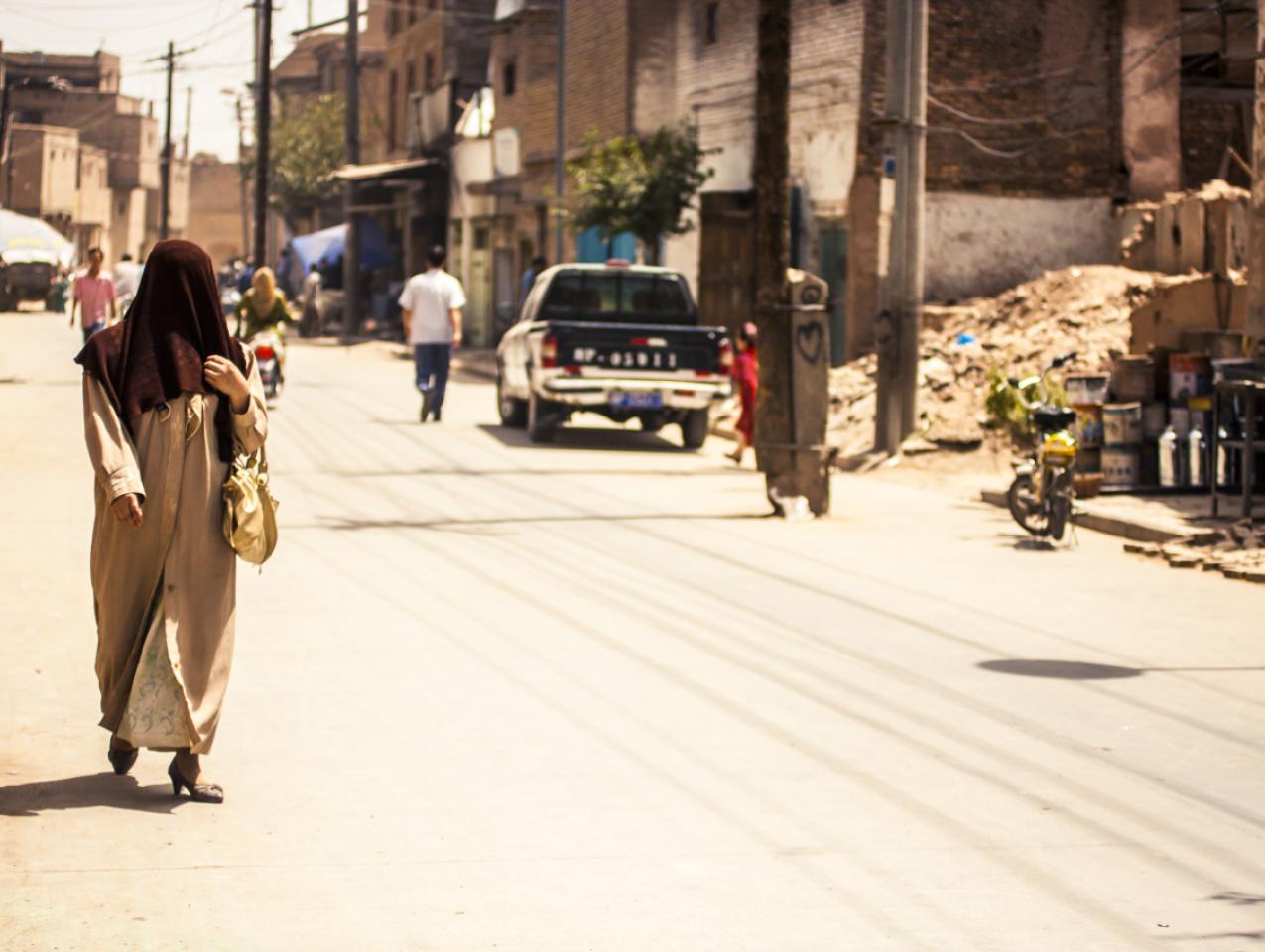China’s relationship with Islam goes back to the 7th century, when Arab merchants and envoys traveled to Canton (Guangzhou) to discuss trade ties with the Tang dynasty. Building mosques and madrassas, hosting preachers, and creating largely homogenous enclaves within China, Muslim communities persisted throughout repeated disintegration and reformation of Chinese dynasties. Islamic nationalism inside China grew with Arab nationalism outside it, even as the Chinese imperial system was decaying, to be replaced by the atheist Chinese Communist Party. Today, Beijing seeks to increase its influence with the Islamic world outside its borders, but has embarked on a new cycle of domestic repression, directed primarily towards the ethnic Uighur population of northwestern China. This tension is perhaps the defining feature of contemporary China’s relationship with Islam.
Coming less than a generation after the death of Muhammad, the first embassy, traditionally dated to 651 AD, cemented Islam’s connections to China from early in its history. Muslim merchants soon began establishing themselves in key Chinese trading centers. Muslims during these centuries played a variety of roles, often responding to the currents of Chinese history: as mercenaries during the 11th and 12th centuries, large-scale emigrant communities during the Mongol Dynasty, rebels loyal to the Ming Dynasty after the 1644 establishment of the Ch’ing (Qing) Dynasty, and proto-“nationalists” attempting to establish Muslim states in western China during the 19th century. Within imperial China itself, periods of tolerance and acceptance of Islam alternated with eras of repression.
During the Ming (1368-1644) and Ch’ing (Qing; 1644-1911) Dynasties, the state attempted to Sinicize Muslim communities, reducing the freedom they had known under the Mongols. New immigrants were increasingly forced to settle in borders zones, particularly in the northwest and southwest, while Ch’ing imperial conquests added new Muslim populations from Central Asia. The far western borders of empire became the areas of largest Muslim concentration, remaining until today as the center of Muslim settlement. The upheaval of Mao Zedong’s Cultural Revolution in the 1960s and early 1970s also shook Islamic communities in China as ethnic minorities throughout the country faced increased oppression. Only in the 1980s were restrictions relaxed on religious observances, mosque building, and religious instruction, which not coincidentally resulted in radical ideas entering through new religious schools and other contacts with the Islamic world.
There are approximately 25 million Muslims in the People’s Republic of China (PRC) today, comprising roughly 2 percent of the total Chinese population. The two largest Muslim nationality groups are the Hui, numbering 10.5 million, according to the 2011 census, and the Uighurs, comprising over 11 million persons. The Hui, spread largely throughout provinces in northwestern China, have largely assimilated into Chinese society, including through intermarriage. The Chinese government has allowed the Hui population to maintain its religious identity, speak Arabic, build mosques, and even participate in trans-national Islamic observances, such as the haj. Arabic-speaking ethnic Hui have also served as merchant middlemen, linking Chinese business with Central Asia and Arab Gulf states.
The same cannot be said for the Uighurs, who live primarily in the northwestern province of Xinjiang. Uighurs are more closely related to Turks and Uzbeks, speak their own language, and have resisted both intermarriage and assimilation. Incorporated into the Ch’ing Empire in the late-19th century and annexed in 1949 by the new Communist government, Xinjiang has become the epicenter of Chinese Muslim resistance to Beijing. The Uighur separatist activists, now organized as the Turkistan Islamic Party, but better known as the East Turkmenistan Islamic Movement (ETIM), protest Beijing’s repressive, discriminatory policies, and have become the largest domestic extremist group in China. Beijing has charged ETIM with conducting more than 200 violent attacks since 1990, but its militant activities increased particularly after the Iraq War, including bus bombings in Shanghai and Kunming, multiple sword and knife attacks at train stations in major cities, and a car bombing in Tiananmen Square, the symbolic center of China, among other incidents. Early support for ETIM from the Taliban tied the group to the transnational jihadist network, and it maintains ties to the Pakistan Taliban. Beijing accuses Al Qaeda of giving material and moral support to both ETIM and the successor TIP, and the group has been declared a terrorist organization by the PRC, the European Union, and other nations.
Beijing’s attempt to control Xinjiang has led to severe repression over the past decade. The province has become in essence a police state, with a massive paramilitary force; ubiquitous, intrusive surveillance; regular roundups of suspected radicals; and a crackdown on civil society. Foreign reporters and scholars find it difficult, sometimes impossible, to get access to the province, and even writing about Xinjiang can cause blacklisting and denial of future visas to visit the PRC. Social media stories about Chinese authorities cutting the long dresses of Muslim women in Xinjiang revealed one variant of the new Sinification taking place. More controversially, reports from Chinese state media on mandatory “heath examinations” in Xinjiang have led to claims of forced DNA collection from Uighurs. Most recently, multiple accounts that Beijing is incarcerating up to one million Uighurs in “political education centers” in the province have raised the specter of modern concentration camps.
From one perspective, Uighur radicalization represents merely the most extreme version of ethnic separatism in China today. The Han majority, which comprises over 91 percent of the Chinese population, has long pressured and actively suppressed ethnic minorities, as part of a strategy for ruling one of the most linguistically and ethnically diverse polities on earth. From Tibetans to Tatars, and from Kazakhs to Uzbeks, today’s Chinese empire is built on the control of dozens of minority groups and the tight monitoring of their religions. In response, separatist movements have emerged throughout China, but few have become as radicalized or threatening as Islamic groups.
Uighurs portray themselves as freedom fighters, challenging Beijing for their independence, little different from Tibetans or Taiwanese, other than being ethnically distinct and Muslim. They deny that most Uighurs are part of a global jihadist movement, and point to the government’s imprisonment of moderate academic Ilham Tohti as just one more piece of evidence that Beijing suppresses all Uighurs, not just radicals. Yet China’s suppression of Uighur Muslims has fed into the hands of external jihadists, helping lead to a radicalization of young Chinese Muslim males over the past generation. Islamism in China is therefore a foreign policy problem as well as a domestic one.
For the Chinese government, conflict with the Uighurs and suppression inside Xinjiang have a geopolitical aspect, potentially threatening Beijing’s relations with Muslim governments in Central Asia and the Middle East. More threateningly, any intensification of outside support, such as from the Taliban or Al Qaeda, for Uighur or other Islamist radicals inside China raises the specter of the need for some type of external response. The Chinese government, however, has no desire to become ensnared in a generation-long battle with Islamist terrorists outside the country’s borders, as has happened to the United States. Thus, while Beijing has repeatedly attempted to link ETIM to Al Qaeda and other transnational Islamist terror groups in order to get counter-terrorism support from the United States, it has shown little appetite for any cross-border actions.
Just as importantly from a geopolitical perspective, Xinjiang sits squarely along Beijing’s “One Belt, One Road” (OBOR) corridor. Chinese President Xi Jinping’s marquee foreign policy initiative, OBOR aims to link Eurasia through infrastructure development and land- and maritime-based trade routes, reaching all the way to Western Europe. Xinjiang occupies a geostrategic location along the Belt and Road, as the access point to much of Central Asia. It also is the gateway to Pakistan’s Karakoram mountains, through which the $62 billion China-Pakistan Economic Corridor runs. Just as importantly, Xinjiang contains vast natural resources, with estimates of up to 5 billion barrels of oil in the province’s Junggar Basin and up to 13 trillion cubic meters of natural gas. Xinjiang has been China’s top oil and gas producing region since the mid-2000s, critical to the country’s import-dependent economy and the fortunes of state-owned energy enterprises. Any effective resistance to Chinese control over Xinjiang, let along the formation of an independent Islamic republic, would pose a threat to Beijing’s plans to increase its influence throughout Eurasia.
China’s Uighur problem poses yet another threat, an ideological one: undercutting Beijing’s pretensions to be the standard bearer for anti-imperialist, pro-non-Western powers seeking to redress the wrongs of the post-World War II global system. In portraying itself as the “anti-America,” and more particularly under Xi Jinping the “anti-Trump,” China’s hypocrisy on the Uighur issue is a potential time bomb. The outside world is just beginning to learn of the scale of human rights violations in Xinjiang, yet Beijing has long castigated Washington for America’s interventions and military operations abroad, as well as for its supposed mistreatment of minorities at home. Not only jihadists, but their backers in Iran as well as conservative Islamic regimes around the world may stop turning a blind eye to the suffering of their co-religionists, and choose to provide greater support, no matter how surreptitiously. The type of response Beijing makes to such potential interventions in its domestic affairs will test its ability to maintain control at home and counter external meddling while continuing to expand its influence in Central Asia and the Middle East.
Ethnic separatism, driven by religious radicalization, is one of the greatest fears of the Chinese Communist Party. As a multi-ethnic empire, the PRC cannot allow successful independence movements in any of its subordinated areas for fear of contagion. This political concern is heightened by the transnational nature of the Islamist movement. Even moderate Muslims in Xinjiang are perceived by Beijing as a threat, the leading edge of a radicalization movement that could challenge central control of the strategic province, as well as infect other Muslims in China and spill over to other regions.
Given these realities, there is little likelihood that Beijing will ease its pressure in Xinjiang for the foreseeable future. State repression, enhanced by advanced surveillance technologies and censorship of much information, will ensure continued government control of the Uighur population. At the same time, China will continue to try to increase its trading relations and political influence throughout the Islamic world. Yet even if Beijing’s domestic repression results in global condemnation, greater radicalization of China’s Muslims, or other types of backlash, the only real option from the Communist Party’s view is to maintain a firm grip, ignore criticism, and react as quickly and firmly as possible to any new threats emerging from its present course. China’s long encounter with Islam will remain torn by the inherently irreconcilable tensions at its core.
















